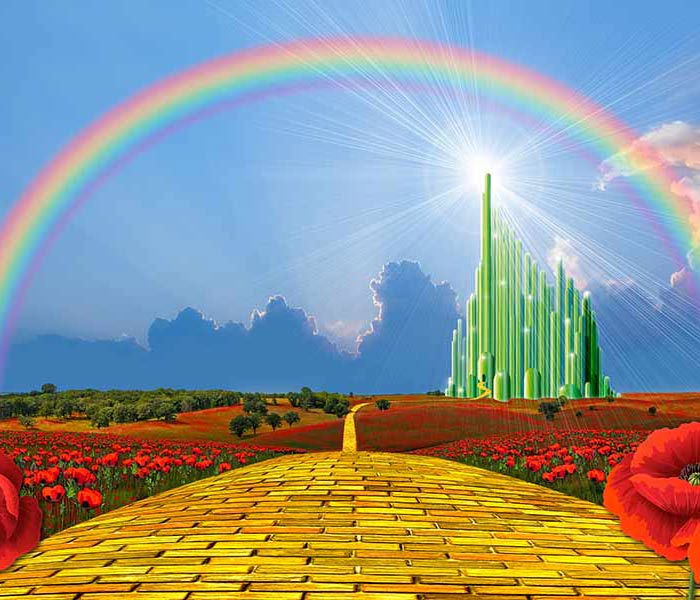 “The Wizard of Oz,” Metro-Goldwyn-Mayer’s 1939 musical version of L. Frank Baum’s 1900 children’s book “The Wonderful Wizard of Oz,” is an American classic. In fact, the Library of Congress has stated that the film is the most-watched movie--ever. Whether you’ve seen it up on the silver screen or watched it from the comfort of your own home, you’ve probably seen Dorothy and Toto’s journey from their home in Kansas to the spectacular land of Oz. And even if you haven’t seen the film itself, it is nearly impossible not to be familiar with America’s homegrown fairy tale. Dorothy, Toto, and her companions have all entered the cultural lexicon in ways few characters ever have.
“The Wizard of Oz,” Metro-Goldwyn-Mayer’s 1939 musical version of L. Frank Baum’s 1900 children’s book “The Wonderful Wizard of Oz,” is an American classic. In fact, the Library of Congress has stated that the film is the most-watched movie--ever. Whether you’ve seen it up on the silver screen or watched it from the comfort of your own home, you’ve probably seen Dorothy and Toto’s journey from their home in Kansas to the spectacular land of Oz. And even if you haven’t seen the film itself, it is nearly impossible not to be familiar with America’s homegrown fairy tale. Dorothy, Toto, and her companions have all entered the cultural lexicon in ways few characters ever have.
“The Wizard of Oz” was a critical darling, too. The film was nominated for Best Picture of the Year but lost out to “Gone With The Wind,” another 1939 blockbuster. Nevertheless, Judy Garland’s wistful rendition of “Over the Rainbow” won the Best Original Song category.
In addition to Garland, the actors who portrayed the main characters, most of whom appear as both their Kansas selves and their Oz iterations, including the following:
While you may have the movie script practically memorized — think “Toto, I have a feeling we’re not in Kansas anymore” — what you may not know is that, over the years, the film and its source novel have been subject to some pretty interesting interpretations. The most famous is probably the populist interpretation, which was first put forth in 1964 by educator Henry Littlefield. Littlefield proposed that the original Oz story was actually an elaborate commentary on the gold standard, a monetary system where a nation’s currency is directly equivalent to a specific amount of gold. The Yellow Brick Road represents the gold standard and the Silver Shoes (changed to Ruby Slippers in the film) represent the movement to make silver a monetary standard alongside gold. 'Oz' is even the abbreviation of ounces, the unit used to measure the weight of gold.
Littlefield was not the only person to propose his own interpretation, though. Some atheists have also suggested that "The Wizard of Oz" is an allegory of an atheist’s journey to self-discovery from the wicked bonds of religion and superstition, to the mind-freeing realization that there is no God and the all-powerful wizard behind the curtain is nothing more than a man determined to rule Oz for his own malicious and self-serving purposes.
The Atheist Version
If one takes "The Wizard of Oz" as an allegory, you can delve even deeper into the proposed atheist interpretation. Dorothy stands in as the would-be atheist. Toto is Dorothy’s critical thinking ability. The Wicked Witch is the local church, focused on destroying anyone who opposes her, no matter how small. And Glinda, the Good Witch, is the learned atheist out to help along those who are just getting their feet wet with atheism.
Each of Dorothy’s companions can be viewed as a part of the atheist’s journey. The Scarecrow, who needs a brain, is the atheist’s desire for knowledge. The Tin Man, who needs a heart, is the atheist’s desire for ethics grounded in humanism, rather than religion. And the Cowardly Lion, who needs courage, is the atheist’s desire for the strength to resist the persecution of religious individuals.
Like in most allegories, even inanimate objects and plot devices hold meaning. For instance, Dorothy’s home-life in Kansas being shot in black and white shows Dorothy’s lack of clarity before her atheist enlightenment. The “horse of a different color” Dorothy encounters in Oz represents a different way of looking at the simple things that made up her life in Kansas. And the Yellow Brick Road is the path of reason, each brick held in place by the mortar of logic.
Admittedly, that is a lot of meaning to impose on a children’s book. But allegory doesn’t have to be intentional by the author. And through the ages, the original book and the 1939 film adaptation have been analyzed through just about every lens. There are some out there who think the story was intended as a strong feminist statement, and there are those who even believe the story is a religious allegory. Author Ken Kesey even envisioned the story as an allegory for an LSD trip.
We’ll probably never know if L. Frank Baum intended the story strictly as a fun fantasy romp for children, or if he injected secret meaning into the story. Most likely it was written as a fun and magical children's tale. But the fun part of critical examination is discovering what something means to you. Propped up with a strong, well-sourced argument, one can argue meaning in many works of fiction, particularly fairytales. Was "The Wizard of Oz" intended as an atheist allegory? Probably not. But that is a valid reading of a classic tale.
Add Your Comment